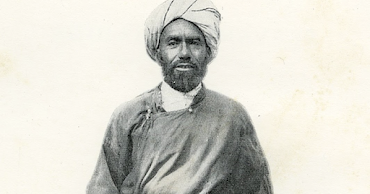On 3rd Galwan Anniversary - Profile of Ghulam Rasool Galwan
Ghulam Rasool Galwan, a Ladakhi explorer from Leh, was the first to explore the course of the river. In 1892. He was part of a British expedition team that was exploring the areas to the north of the Chang Chenmo valley when they ran into this previously unknown river valley, which was later named after him. This is one of the rare instances where a major geographical feature is named after a native explorer.
As it happened that on a mission with Dunmore Murray, 7th
Earl of Dunmore, he was part of a group that hit a wall of tall mountains and
steep gorges with no possible way out. The 14-year-old boy, Ghulam Rasool Galwan
instead went ahead to search for a possible route out. To everyone’s surprise,
he found a relatively easier passage through the ravines that helped the
expedition to go ahead without much difficulty. Impressed, Dunmore Murray
decided to name the newfound passage through the edge of water naming it as Galwan
nullah or river.
Named after Ghulam Rasool Galwan, the 80 kilometers-long
Galwan River, which flows through the Galwan valley, in the eastern part of
Ladakh is the flashpoint of a five-week border row that has turned into a
violent confrontation, the first in last 45 years. The river originates from
the Aksai Chin region and joins the Shyok River inside Indian territory west of
LAC to form an upstream tributary of the Indus River. On the fateful Monday night of 15th
June 2020, a violent escalation took place between the Indian Army and China's
People's Liberation Army Border Defense Regiment (PLA-BDR) that resulted in the death of 20 Indian Army personnel in the Galwan Valley.
Ghulam Rasool Galwan, either led or was part of numerous
expeditions into Tibet, Yarkand in Xinjiang, the Karakoram range, the Pamirs, and other Central Asian regions — mostly through inhospitable geographies with
altitudes ranging from 5,000 m to 7,000 m above sea level where temperatures
plunged to -30 degree Celsius in winter.
According to the book 'Forsaking Paradise: Stories from
Ladakh', Ghulam Rasool Galwan assisted Francis Younghusband to scout the
region as a guide when he came to Leh in 1895. At that time when British-ruled
India was worried about Russian expansion toward Tibet. He wrote a book, an
autobiography titled ‘Servant of Sahibs: A Book To Be Read Aloud’,
published in 1923 by Cambridge-based W Heffer & Sons Ltd, where he is said
to have written about his life of journeying and adventures The foreword of
this book is written by Francis Younghusband, a British explorer and leading
figure in 'The Great Game' between the British and Russia. In this book, he offers
a glimpse into his early childhood of growing up in such a strategically
important and sensitive region.
Galwan was forced to go on risky, long-distance expeditions
when he was just 12, to supplement the meager and inconsistent income of his
family. Born in Leh, in 1878, he left home at the age of just 14 in search of
work. He had a passion for finding new places and this passion made him a
favorite guide of the British. Starting out as a porter and pony man, he assisted
expeditions led by British, Italian, and American explorers for almost 35
years, eventually becoming ‘aksakal' or chief assistant of the British joint
commissioner of Leh in 1917.
Ghulam Rasool Galwan was not very well educated but was a
keen learner and learned to speak many languages from Francis Younghusband
including Chinese, and English. Besides native Ladakhi, he also spoke Turki,
Urdu, Kashmiri, and Tibetan. In 1899, he started trekking from Leh and reached
many new areas around Ladakh.
Ghulam Rasool Galwan belonged to the Galawan tribe, which means horse-keeper in the Kashmiri language. It is believed that Ghulam Rasool Galwan’s maternal grandfather was a robber named Kara Galwan, which in the Kashmiri language means Karra (black) and Galawan (robber) or black robber. Karra was the keeper of his clan, he only looted the houses of the rich and distributed the money among the poor. After some time, the Dogra king’s soldiers captured and beheaded him. After this, the people of the Galawan clan moved to Leh and Baltistan. Many Galwanis settled in Yarkand in Xinjiang province. Ghulam Rasool Galwan wrote a story about this as narrated by his mother in his book. He died aged 47, in 1925. The Chamspa Yortung Circular Road of Old Leh is home to Ghulam Rasool Galwan's family. There is a ‘Galwan Guest House’ named after him. Currently, some members of his fourth-generation family live here.





On 3rd Galwan Anniversary - Profile of Ghulam Rasool Galwan
ReplyDelete